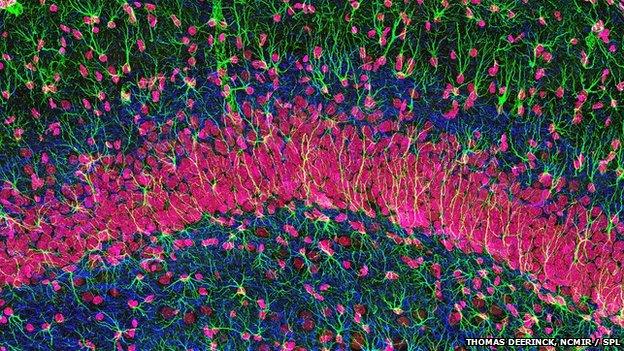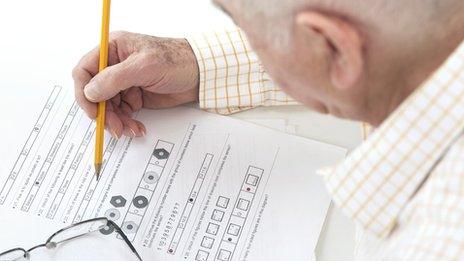Similar memories benefit from 'extra space' in brain
- Published

The study concerns a sub-region of the hippocampus (red), which itself is a small but crucial brain area
Similar memories overlap physically in the brain and this produces less confusion if the brain area responsible is larger, according to new research.
Scientists scanned the brains of 15 people recalling four similar scenes, in a study published in PNAS, external.
They spotted overlapping memory traces in a specific corner of the hippocampus called "CA3", a known memory area.
If their CA3 was bigger, the subjects were less confused and there was less overlap in the traces.
Most of us store many similar memories, relating to the places we spend most time and the people we know best. Normally we can tell them apart, though some of us may be better at it than others.
The CA3 region was thought to process each memory using distinct sets of brain cells. These findings suggest, however, that when two episodes incorporate similar content, they may in fact be "remembered" by physically overlapping networks - and more space could be beneficial.
"Our results may help to explain why we sometimes find it difficult to differentiate between similar past memories, and why some people are better at doing this than others," said Prof Eleanor Maguire, the study's senior author, from the Wellcome Trust Centre for Neuroimaging at University College London (UCL).
The 15 subjects watched four short movies, showing two different actions happening in each of two different places. They were then prompted to remember each one, 20 times over, inside a brain scanner.
Scans revealed distinguishable memory activity in the CA3 region, but not three other compartments of the hippocampus. Importantly, the four different memory traces showed significant overlap.
Furthermore, that overlap was more apparent in people who said they were more confused by the similarities between the four memories.
Greater capacity
The scans combined fMRI (functional magnetic resonance imaging) with detailed structural measurements of each brain, so as well as getting a read-out of brain activity, the team could measure the exact size of each person's CA3.
That was how they discovered that the size of this region, relative to the rest of the hippocampus, affected both the amount of overlap in the traces and the level of people's confusion.
"A larger CA3 may contain more neurons or more connections between neurons, which could allow greater physical separation of the different memory traces," Dr Martin Chadwick, who conducted the experiments, told BBC News.
Although overall brain size is not related to different individuals' mental abilities (Einstein's brain was smaller than average, external), the relative dimensions of different components have been linked to various characteristics.

The populations of cells that process each memory in the hippocampus may overlap
An earlier study, external by Prof Maguire famously showed that as they hone their impressive mental street maps and navigational ability, London cab drivers develop a larger hippocampus, on average, than the rest of us.
Dr Hugo Spiers, a neuroscience lecturer at UCL who was not involved in the research, described the new paper as a "really useful" addition to that classic finding. "[The hippocampus] is quite a lot of brain," he told the BBC. "What they've now found is that this particular bit within it, the CA3, which is a very exciting bit of the brain, is larger in some people."
"The taxi driver study is about the overall size being related to navigating a big city, but that's very different to remembering what each of you said in an argument you had with your partner the other day. Most of us are really bad at that - it ends up as 'You said this' 'No I said that' - it might be the size of CA3 that influences who's going to win that argument!"
The CA3 region is remarkable because its widespread connections to other pockets of the brain are accompanied by a vast number of interconnections within the CA3 itself. This marked it out years ago, Dr Spiers explained, as a potentially useful component for memory storage and retrieval.
"You want something to reconnect with itself a lot, to allow you to retrieve rapidly stored memories - but it's got a limit," he said.
"We've got a better understanding, from this new work, about what this particularly important bit of the memory circuitry is doing."
- Published6 June 2014

- Published20 February 2014

- Published25 August 2013
